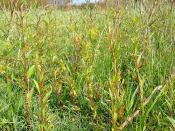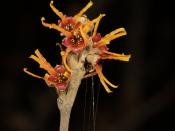One of the uncommon plants in the botanical garden is the witch hazel. Witch hazels provide unusual interest at times of the year when other garden flowers, shrubs, and trees are dormant.
Witch hazels belong to the family Hamamelidacae and are related to other garden species familiar to devoted gardeners. Fothergilla, Paerotia, Corylopsis, and many others less well known woody shrubs and trees, including the American sweetgum, all belong to the witch hazel family. Members of the witch hazel family have a number of features in common:
1. Good to excellent fall foliage.
2. Shade and wet soil tolerance.
3. Minimum of garden pests.
Most of the plants in this family also flower at times when other flowering trees and shrubs don't, which makes them extremely useful in the garden. Witch hazels may flower in the autumn, the winter , or the very early spring. The flowers of all species of witch hazel produce a delightful fragrance.
The flowers consist of 1-inch wide displays of narrow, strap-like petals ranging from light yellow through oranges to bronze and even brick red.
The fall-blooming witch hazel is the largest shrub of the family. Plants often reach 20 feet or greater in height. The flowers are light yellow and reach their peak before, during, and following the brilliant yellow fall foliage display.
The winter- and spring- blooming witch hazels tend to be showier because the floral display is not blocked by leaves. Chinese witch hazel is the most fragrant of all and typically has the largest flowera, but leaves occasionally show heavy powder mildew in later summer. This species is also the least tolerant of cold. Temperatures of - 15 degrees will kill flower buds. Vernal witch hazel is the most cold tolerant of the winter and spring booming species. It...


